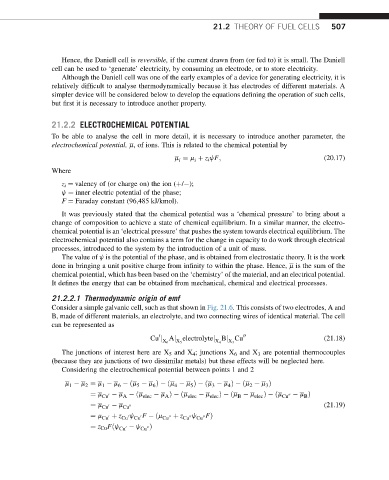Page 514 - Advanced thermodynamics for engineers
P. 514
21.2 THEORY OF FUEL CELLS 507
Hence, the Daniell cell is reversible, if the current drawn from (or fed to) it is small. The Daniell
cell can be used to ‘generate’ electricity, by consuming an electrode, or to store electricity.
Although the Daniell cell was one of the early examples of a device for generating electricity, it is
relatively difficult to analyse thermodynamically because it has electrodes of different materials. A
simpler device will be considered below to develop the equations defining the operation of such cells,
but first it is necessary to introduce another property.
21.2.2 ELECTROCHEMICAL POTENTIAL
To be able to analyse the cell in more detail, it is necessary to introduce another parameter, the
electrochemical potential, m, of ions. This is related to the chemical potential by
m ¼ m þ z i jF; (20.17)
i
i
Where
z i ¼ valency of (or charge on) the ion (þ/ );
j ¼ inner electric potential of the phase;
F ¼ Faraday constant (96,485 kJ/kmol).
It was previously stated that the chemical potential was a ‘chemical pressure’ to bring about a
change of composition to achieve a state of chemical equilibrium. In a similar manner, the electro-
chemical potential is an ‘electrical pressure’ that pushes the system towards electrical equilibrium. The
electrochemical potential also contains a term for the change in capacity to do work through electrical
processes, introduced to the system by the introduction of a unit of mass.
The value of j is the potential of the phase, and is obtained from electrostatic theory. It is the work
done in bringing a unit positive charge from infinity to within the phase. Hence, m is the sum of the
chemical potential, which has been based on the ‘chemistry’ of the material, and an electrical potential.
It defines the energy that can be obtained from mechanical, chemical and electrical processes.
21.2.2.1 Thermodynamic origin of emf
Consider a simple galvanic cell, such as that shown in Fig. 21.6. This consists of two electrodes, A and
B, made of different materials, an electrolyte, and two connecting wires of identical material. The cell
can be represented as
0
Cu j Aj electrolytej Bj Cu 00 (21.18)
X 6 X 5 X 4 X 3
The junctions of interest here are X 5 and X 4 ; junctions X 6 and X 3 are potential thermocouples
(because they are junctions of two dissimilar metals) but these effects will be neglected here.
Considering the electrochemical potential between points 1 and 2
5
1
2
4
m m ¼ m m ðm m Þ ðm m Þ ðm m Þ ðm m Þ
2
3
3
4
5
6
1
6
¼ m Cu 0 m ðm elec m Þ ðm elec m elec Þ ðm m elec Þ ðm Cu 00 m Þ
B
A
B
A
¼ m Cu 0 m Cu 00 (21.19)
¼ m Cu 0 þ z Cu 0j Cu 0F ðm Cu 00 þ z Cu 00j Cu 00FÞ
¼ z Cu Fðj Cu 0 j Cu 00Þ

